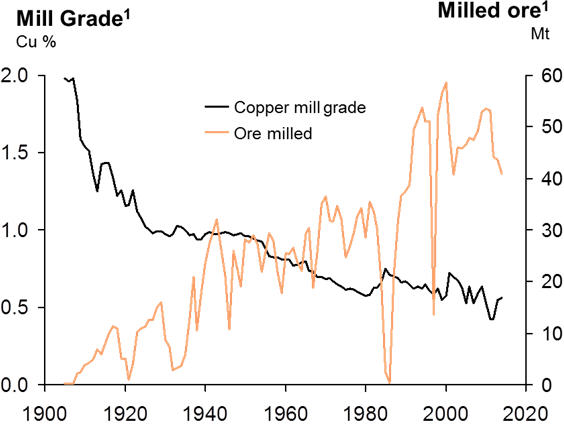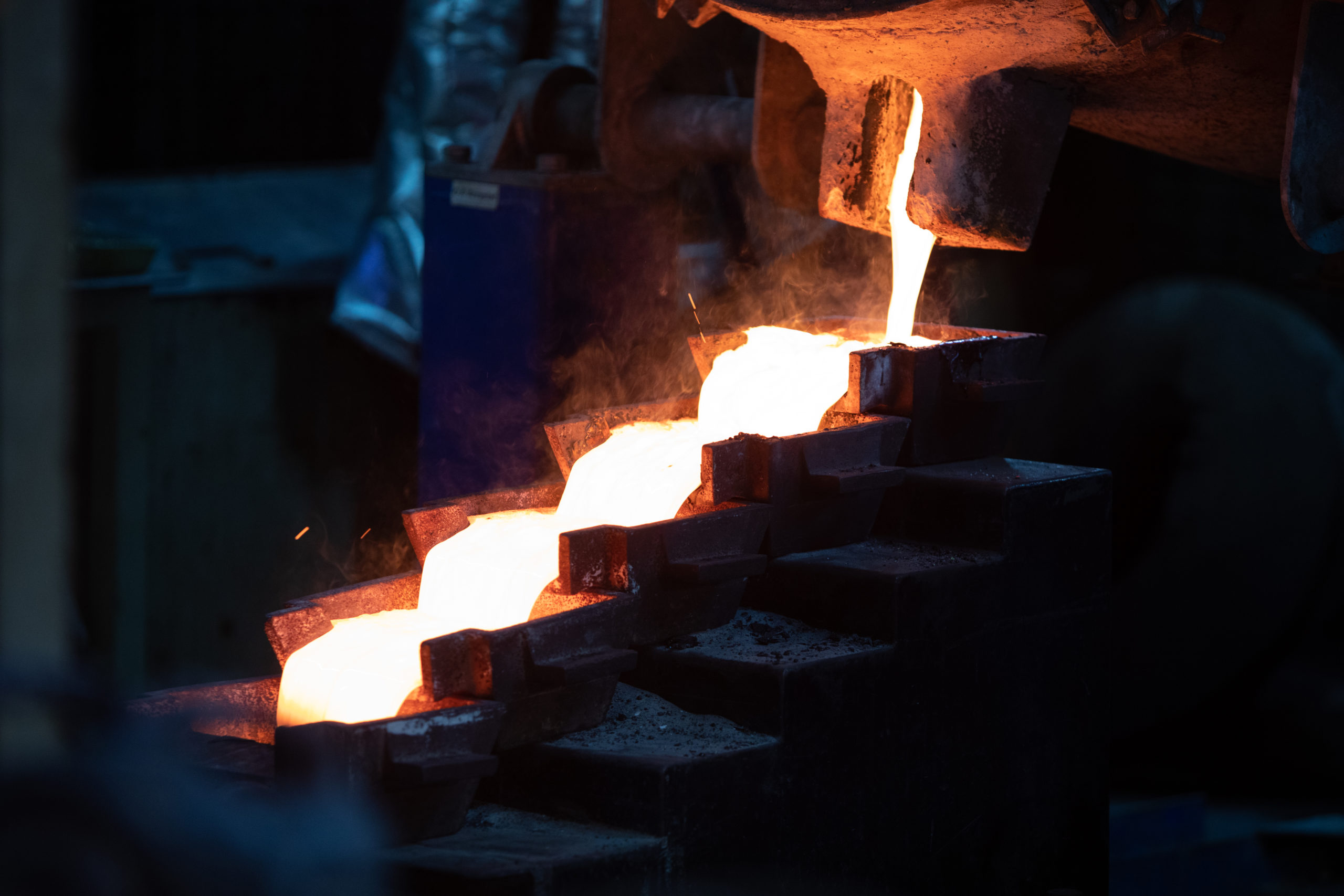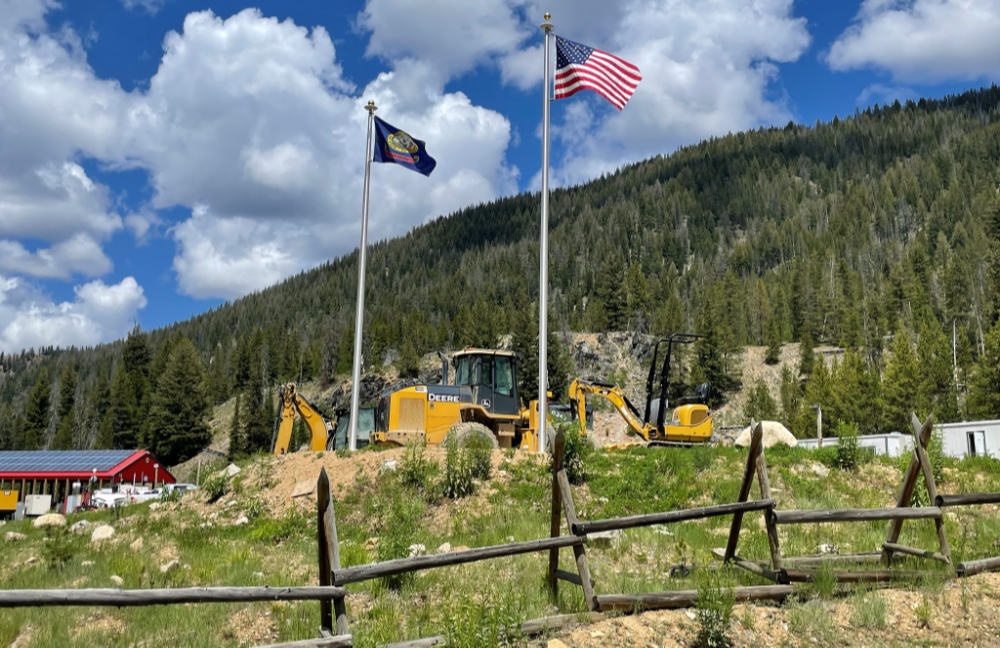Heap Leach: Mining’s breakthrough technology
Amid turmoil on commodity markets and a relentless drive by mining companies to increase efficiencies, heap leaching has emerged as a breakthrough technology experiencing stunning growth over the past decade
According to the World Economic Forum’s Mining & Metals scenarios to 2030 report, “global population growth – together with upward trends in urbanization and industrialization, particularly in emerging economies – has led to a strong increase in demand for commodities from the mining and metals industries. This growth is highly likely to continue and will place pressure on the demand of resources”.
While demand is expected to rise steadily, supply has not always kept pace. Grades of metals in ore of metallic deposits decreased significantly over the past decades (Figure 1). World class deposits discovery rates are falling and a growing number of new mines use higher-cost and technically challenging underground mining methods.

Figure 1. Evolution of copper ore mill grade at the Bingham Canyon mine, USA. Source: IntelligenceMine
All these factors, combined with growing resource nationalism, global water supply issues, as well as stricter environmental and other permitting regulations, raise great concerns over the sustainability of future supplies of primary metals.
Under these circumstances, mining companies are proactively seeking advanced technologies that could allow them to reduce costs and increase performance. Producers are also looking for ways to gain access to resources that at present are considered abandoned or uneconomic.
What is Heap Leaching?
Heap leaching (HL) is a flexible and constantly developing mineral processing and extraction technology that is gaining popularity and recognition for existing miners and developers. HL has solid advantages over traditional metallurgical methods, where economically feasible options have become limited.
Attend Heap Leach Solutions 2015. September 13 to 16 in Reno, USA
Generally, the HL process involves the following steps:
- Mine the ore
- Crush the ore (if necessary)
- Agglomerate the ore (if necessary)
- Place the ore on a lined pad
- Irrigate the ore with the appropriate lixiviant to dissolve the metals (leachate)
- Collect the leachate in a pond or tank (pregnant or value bearing solution)
- Process the pregnant solution to recover the metals
- Recycle the barren solution (with additional lixiviant) back to the heap.
Figure 2. Simplified general HL scheme.
The main advantages of HL technology are, as follows:
- lower CAPEX and OPEX
- rapid payback
- no tailings disposal
- simple design and equipment
- less environmental concerns
- quick construction phase
- lower energy and water requirements
- applicable to low-grade ore, tailings and waste stockpiles
Currently, HL technology is successfully used to extract gold, silver, copper, nickel, uranium, and even iodine.
Trends in Heap Leaching
Due to abovementioned economic benefits, the number of HL operations has experienced an impressive and sustained growth over the last decades, with precious metal operations benefitting the most from the technology.
The recent commodity market downturn has spurred further commissioning of new HL projects throughout the world (Figure 3).
Figure 3. Start-up of currently operating major Heap Leach mines, # mines. Source: IntelligenceMine.
HL operations are located in wide variety of geographical conditions, and succeed in all types of climate, from the Arctic Circle to the Tropics.
According to the IntelligenceMine’s database, there are 235 active major HL operations worldwide, as well as 39 projects in development and 133 in evaluation phases (Figure 4).
Figure 4. HL projects by status and commodity. Source: IntelligenceMine.
Metal production from HL operations reached considerable proportions since their inception in the 1950s.
Heap Leaching of Gold
In 2014 about 150 major gold-silver mines worldwide utilized HL technology and recovered about 15 million troy ounces of gold, roughly 17% of global gold production (~89 million troy ounces, according to USGS data).
With 970,000 troy ounces of gold recovered in 2014, Newmont/Buenaventura’s Yanacocha mine is the leader in HL of gold, followed by Barrick’s Veladero (722,000 troy ounces of gold) and Lagunas Norte (582,000 troy ounces of gold) operations (Table 1).
Table 1. Top five HL gold facilities. *Source: IntelligenceMine’s ballpark estimation, based on available data.
Aerial view of Kisladag mine, Turkey. Huge HL facility can be seen in the background. Source: Eldorado Gold.
Copper Heap Leaching (Solvent Extraction-Electrowinning – SX-EW)
In 2014, more than 50 major HL-SX-EW operations worldwide recovered approx. 3 million tonnes of copper, which represents roughly 16% of total copper production. With about 327 kt produced in 2012, CODELCO’s Radomiro Tomic mine is believed to takes first place in terms of HL copper output, followed by BHP Billiton’s Escondida and Spence mines (Table 2).
Table 2. Top five HL producers of copper. *Source: IntelligenceMine’s ballpark estimation, based on available data.
As can be seen in Table 2, the five biggest copper HL production facilities are located in Chile. There is no coincidence, since this is the region where the world’s biggest low-grade porphyry copper deposits are located.
Satellite view of Radomiro Tomic copper mine, Chile. HL facilities are located north to the open-pit. Source: Google Earth.
Since 2005, the following notable gold and copper HL operations have been commissioned: Veladero (Argentina), Lagunas Norte (Peru), Kisladag (Turkey), Los Filos (Mexico), Copler (Turkey), Porvenir (Mexico), Karma (Burkina Faso), Caserones (Chile), and many others.
The future of Heap Leaching
It is important to note that the mining industry has managed to implement a number of important advancements which allow producers to push HL boundaries to new more challenging environments. For example, there were new HL operations successfully commissioned in recent years throughout the world aimed to treat material accumulated in past decades in tailings and waste management facilities.
Performance indicators shows stunning success of these kind of operations so far, with 62.4% EBITDA margin achieved at Kounrad HL waste “dumps” facility in Kazakhstan, and a cash cost of $4.29 /oz Ag at the Parral tailings HL project in Mexico.
Kounrad HL facility, Kazakhstan. Old copper waste dumps and new HL-SX-EW plant can be seen. Source: Central Asia Metals Plc.
HL technology has all the chances to succeed in the future, with plenty of opportunities, including HL application to extract massive amounts of precious and base metals sitting in abandoned tailings and waste management sites. Hopefully, recent developments will also allow the use HL to process primary sulfide ores. This would result in a dramatic expansion of the technology as ~80% of total ore types are sulfide in nature.
Heap Leaching, at first sight, seems to be a relatively simple technology, but is in fact, quite a sophisticated process. Many disciplines and specialists have to be involved for HL to succeed, including mining engineers, geotechnical engineers, geologists, environmentalists, analytical specialists, processing chemists, metallurgists, hydrologists and other specialists.
The upcoming Heap Leach Solutions – 2015 Conference to be held September 12-16, 2015 in Reno, Nevada, is a perfect opportunity for all interested stakeholders around HL technology to get together and discuss recent developments, insights and trends in HL.
IntelligenceMine is global mining market intelligence for Researchers, Investors and Suppliers. Get access to more than 45,000 company and property profiles, a powerful multi-faceted search with comparative result grids, sorting and download capabilities, an online interactive mapper and much more. Find out more at www.IntelligenceMine.com.
More News
{{ commodity.name }}
{{ post.title }}
{{ post.date }}










14 Comments
RockHopper
Great overview of heap leaching. The technology has come a long way since the 60s. Impressive how grades have declined and ore milled has increased. Thanks for the article.
Mike Failla
Good article.
Philip S. Baker
IntelligenceMine might be interested in checking out an evaluation project in Jamaica using a sophisticated HL-SX-EW-type approach to extract REEs from bauxite tailings.
Jaime Cortez
Good summary of HL features. Downsides of the process are 1) low predictability of process performance as “hidden factors” abound in comparison with milling- CIL/CIP, 2) lower recovery rates – not good for high-grade material, 3) closure plan, which tends to be expensive, especially in rainy areas (reshaping of slopes, rehandling of material, long-term water monitoring, etc), and 4) larger footprint required (land control, social impact)
Author
As any other technology, HL has its own pros and cons. A the same time, if you do all pre-production steps (all laboratory tests, trial leaching tests, etc.) rigorously, you can, at least, minimize most of the issues related to HL. Thank you for you feedback.
Chris Kuntz
Fabulous article, I would like to speak with stakeholders on the laboratory and metallurgical side of this process.
chris@salasmine.com
Author
Hello Chris. I suggest you to visit upcoming Heap Lech conference in person. All stakeholders around HL process will be there. Please, look here for details: http://www.heapleachsolutions.com
tapuwa dube
what do you want to know on the laboratory and metallurgical side?
mladen
I am not an expert but what does “less environmental concerns” mean? When the operation finishes they just bury the stuff in the ground and leave all the chemicals in there. After year all these mines will be surrounded of heaps full of chemicals. Isn’t it so?
allan
are there any heap leach operations in northern climates? please provide an example
David Handel
Hello, I have a Heap Leach issue where the heap holds too much moisture. Can dewatering chemistry be introduced? Thanks David
joseph machacha
anyone stages from the start to the end of a gold HL and its a proposed costs .
Pineapple
Hi I would just like to say that I will be sueing u for pineapples
Pineapple
Actually nvm I want to still sue but not for pineapples I did a read again and realised no pineapples were harmed but frick you any way